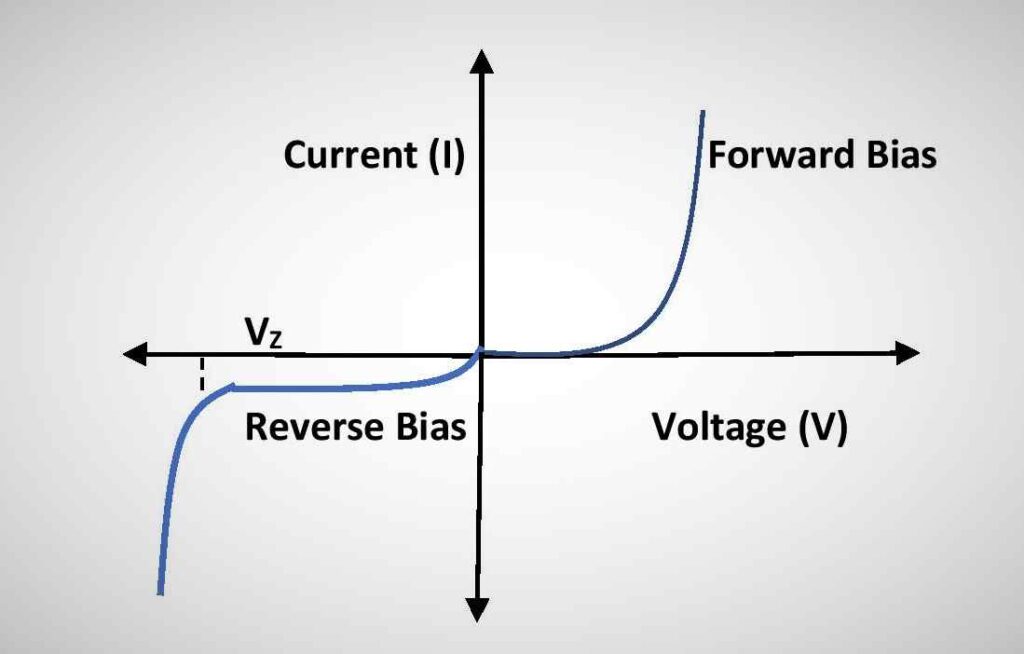A p-n junction diode works properly in forward bias condition. Because a higher amount of current flows for this biasing condition. On the other hand, a very small amount of current flows through the diode when it is connected to a reverse bias. Again, a higher amount of reverse bias voltage can create a breakdown in a p-n junction diode and thereby the diode may be damaged. If you don’t know what is the breakdown of diode, this post is for you! In this informative article, I’m going to share different types of breakdown in a diode and their causes.
What is the Breakdown of Diode?
In reverse bias, a very small amount of reverse current flows through a diode due to the minority carriers. This reverse bias current is almost independent of the reverse bias voltage. But, if we increase the reverse bias voltage, after a certain value of the voltage the reverse current exponentially increases to a very high value. This exponential growth of current in reverse direction is called the Breakdown of the diode and the value of the reverse bias voltage at which the breakdown occurs is known as the Breakdown Voltage.
What are the types of Breakdown in diode?
There are two types of breakdown in diodes –
- Avalanche Breakdown
- Zener Breakdown
What is Avalanche Breakdown?
When a high reverse bias voltage is applied across a lightly doped p-n junction diode, the minority carriers flow with high kinetic energy and collide with crystal atoms. This breaks the covalent bonds of semiconductor crystal and a pair of free electrons produces from each covalent bond. These free electrons have sufficiently high kinetic energy to break other covalent bonds. In this cumulative process, a large number of charge carriers appear even in reverse bias condition of the diode and electric current increases to a very high amount. This phenomenon is called the Avalanche Breakdown in the diode.
What is Zener Breakdown?

For a highly doped p-n junction diode, the width of the depletion layer becomes very small. Therefore, even at a small reverse bias voltage, the electric field across the junction becomes so strong that the electric field can tear out electrons from the covalent bonds by applying a strong coulomb force. In this way, a large number of charge carriers arise in the crystal and the reverse current through the junction becomes very high. This process of breakdown in a diode is called Zener Breakdown.
In the I-V characteristics of Zener diode, Vz is the Zener breakdown voltage at which the reverse current suddenly increases to a high value.
Differences between Avalanche breakdown and Zener breakdown
Normal Diodes cannot work in the breakdown region of the diode. But the Zener diode is a special type of diode that can work in the breakdown region. Zener diode has abilities to handle relatively higher reverse bias voltage and high temperature. Also, Zener diode can work similarly as normal p-n junction diodes in forward bias conditions too.
Let’s see all these differences in tabular form –
| SL. No. | Avalanche Breakdown | Zener Breakdown |
| 1 | Occurs in lightly doped p-n junction diode. | Occurs in heavily doped p-n junction diode. |
| 2 | Breakdown occurs in collision process. | Breakdown occurs by direct rupture of covalent bonds. |
| 3 | A high reverse bias voltage is required. | Zener breakdown occurs at a smaller reverse bias voltage. |
What are Breakdown Diodes?
The diodes that can work at breakdown voltage are the breakdown diodes. For example, Zener diode is a breakdown diode. Doping concentration in Zener Diode is very high and it attains the breakdown region at a very small reverse bias voltage. The breakdown of a Zener diode is known as the Zener breakdown.
We already have discussed Zener diode and its application in another article. You can read it by clicking on the link in blue.
These are the basic concepts of two types of breakdown in a diode and difference between Avalanche breakdown and Zener breakdown. If you still have any doubts on this topic you can ask me in the comment section.
Thank you!
Related posts: